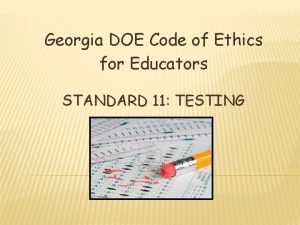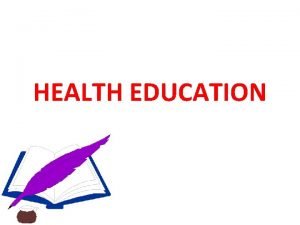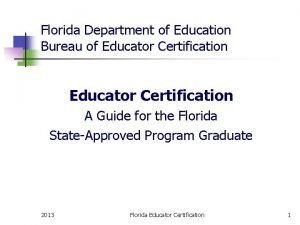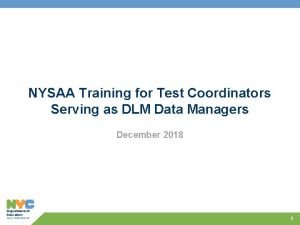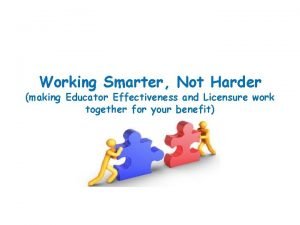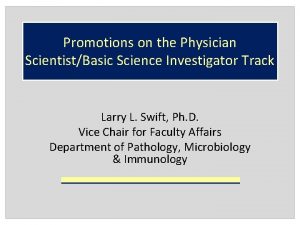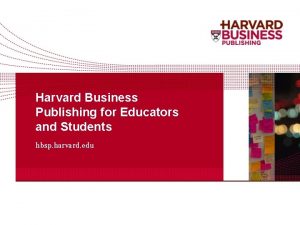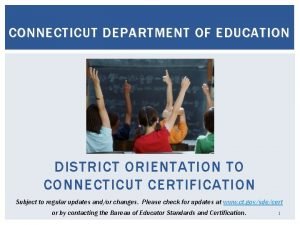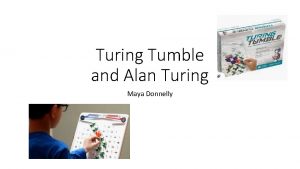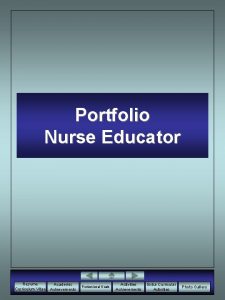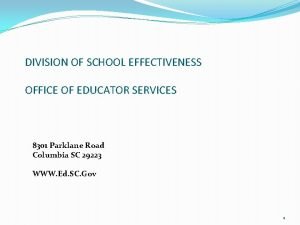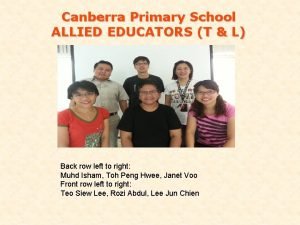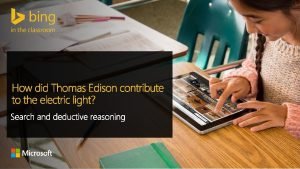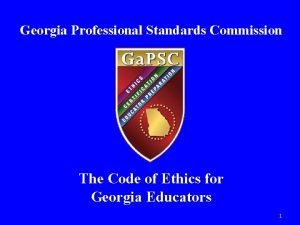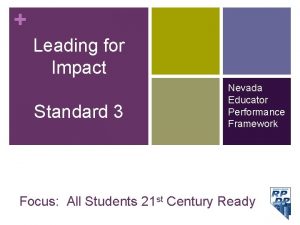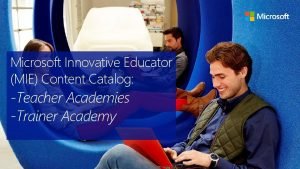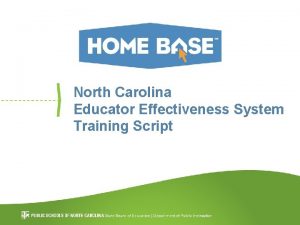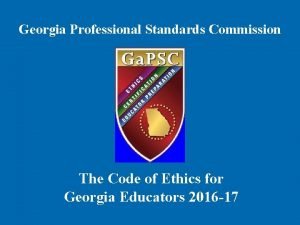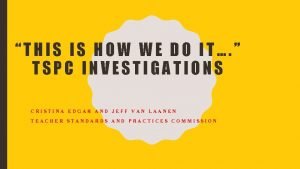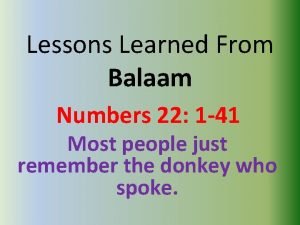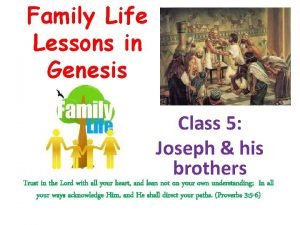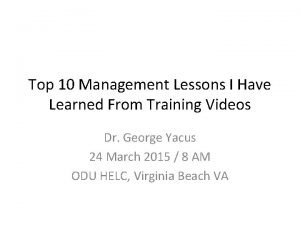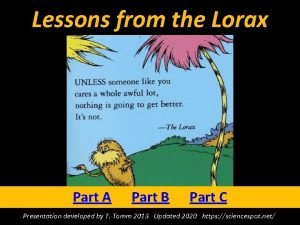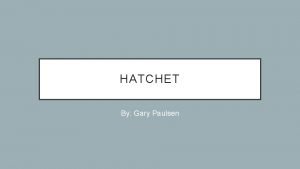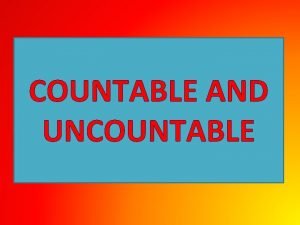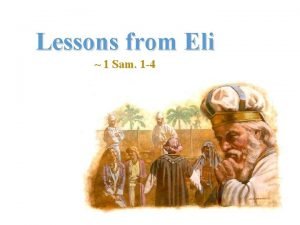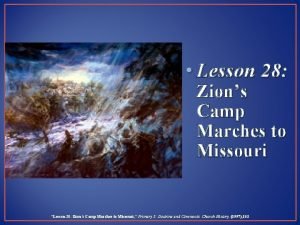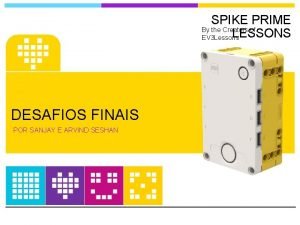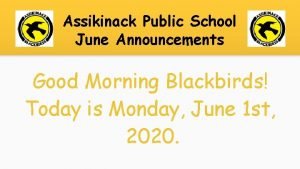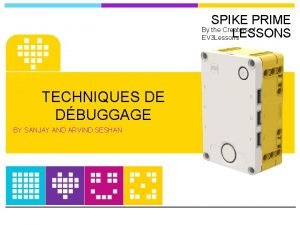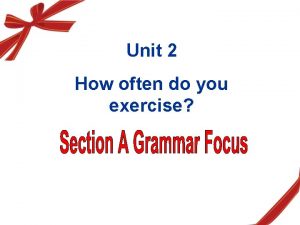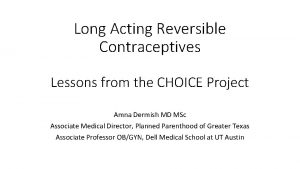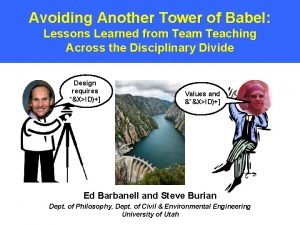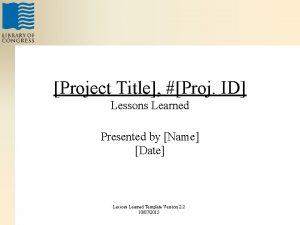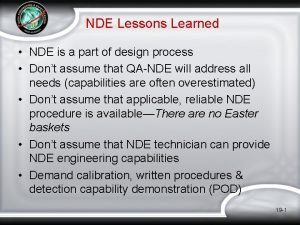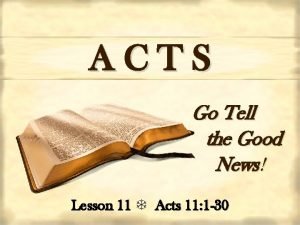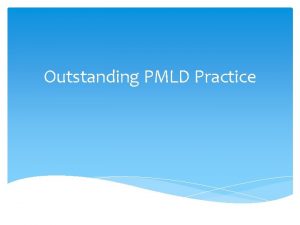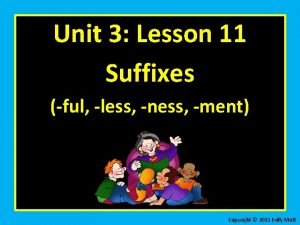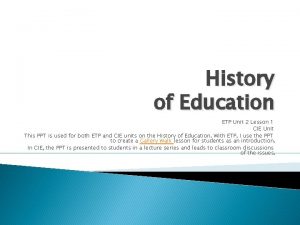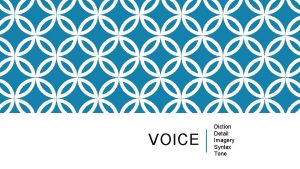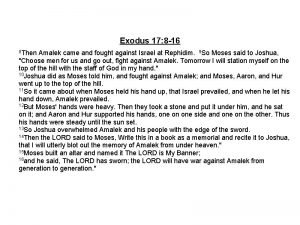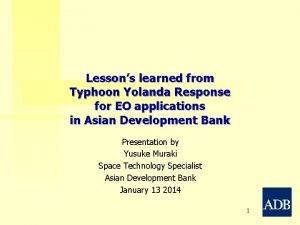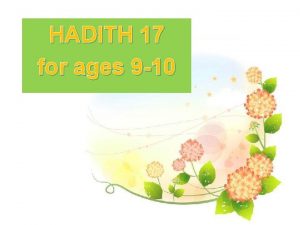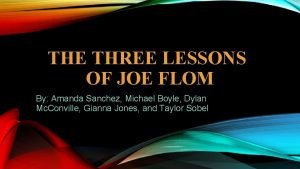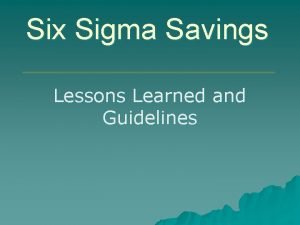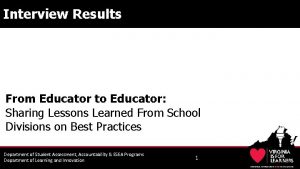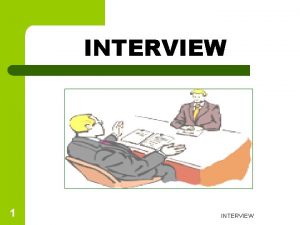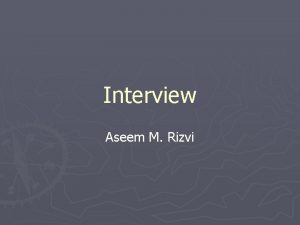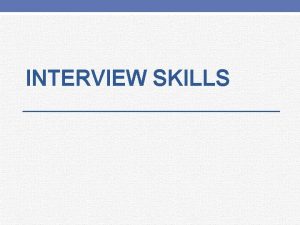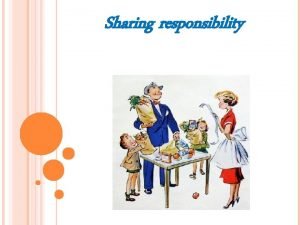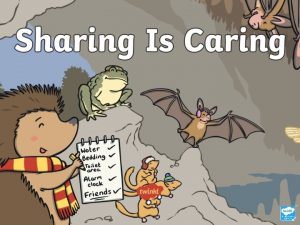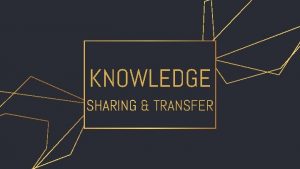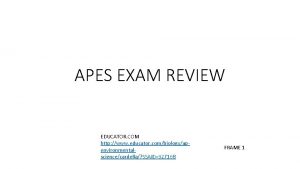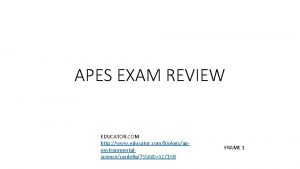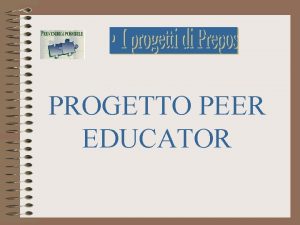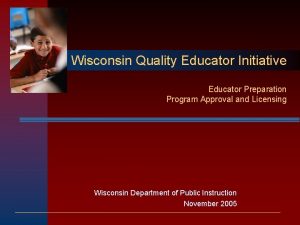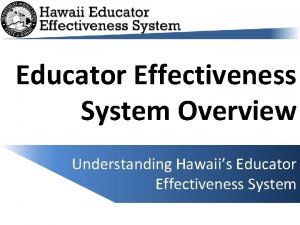Interview Results From Educator to Educator Sharing Lessons



























































- Slides: 59

Interview Results From Educator to Educator: Sharing Lessons Learned From School Divisions on Best Practices Department of Student Assessment, Accountability & ESEA Programs Department of Learning and Innovation 1

Questions During the Webinar • Use the chat feature to pose any questions to the group that arise during the webinar. • Please send your questions to “Host. ” Department of Student Assessment, Accountability & ESEA Programs Department of Learning and Innovation 2

Purpose Department of Student Assessment, Accountability & ESEA Programs Department of Learning and Innovation 3

Conducting Interviews • To assist schools across the Commonwealth in increasing student literacy, VDOE staff interviewed school personnel to identify specific practices and processes used for instruction and assessment. • School personnel shared practices and processes that they believe contributed to students’ success and resulted in improved literacy skills. Department of Student Assessment, Accountability & ESEA Programs Department of Learning and Innovation 4

What We Heard • Information presented was reported to VDOE staff during the interviews. • Participants shared not only information about instructional practices they believe are important but also information about other practices and processes to which they attribute growth in literacy skills. Department of Student Assessment, Accountability & ESEA Programs Department of Learning and Innovation 5

School Selections • VDOE staff requested interviews with a sample of schools that demonstrated a continuous increase in Reading SOL test scores to learn about best practices within those schools during literacy instruction. • Schools were selected based on regional representation and locality type, when possible. • Participants included classroom teachers, division- and schoollevel administrators, English and/or Elementary/Secondary supervisors, key literacy instructional leaders and coaches. Department of Student Assessment, Accountability & ESEA Programs Department of Learning and Innovation 6

Importance of Information Shared (1 of 2) • Interviews offered the opportunity for teachers and other school division personnel to share ideas and expertise about effective comprehensive literacy instruction. • Information shared is authentic and grounded in classroom instruction provided by Virginia teachers and educational leaders across the state. • Educators shared practices that have been adopted and monitored with positive results for student learning. Department of Student Assessment, Accountability & ESEA Programs Department of Learning and Innovation 7

Importance of Information Shared (2 of 2) • Through sharing the information learned during these interviews, VDOE hopes to provide ideas and practices that might help other Virginia educators who are working to improve literacy. Department of Student Assessment, Accountability & ESEA Programs Department of Learning and Innovation 8

Overview • Overall, the information reported to VDOE staff can be categorized in one or more of these areas: – Aligned Curriculum and Instruction – Focus on Literacy – Strategic Use of Data and Assessment – Setting Goals and Monitoring Progress – Supportive Leadership – Targeted Professional Development Department of Student Assessment, Accountability & ESEA Programs Department of Learning and Innovation 9

Aligned Curriculum and Instruction Department of Student Assessment, Accountability & ESEA Programs Department of Learning and Innovation 10

Appropriate Texts (1 of 2) • Participants reported exposing all students to texts that were on grade level rather than a student’s measured reading level. • Participants also reported introducing students to close reading of challenging texts and scaffolding skills for students. Department of Student Assessment, Accountability & ESEA Programs Department of Learning and Innovation 11

Appropriate Texts (2 of 2) • Participants reported intentionally exposing students to high-quality, relevant texts. – In daily life, people are exposed to a wide variety of texts to be read for a variety of purposes. • “Drill the skill” is not authentic to real reading. – Students learn from reading real, published authors. • This was important to reading comprehension and also to teaching writing. Department of Student Assessment, Accountability & ESEA Programs Department of Learning and Innovation 12

“Get books in the hands of kids. ” • Participants reported: – Allowing student choice for independent reading, including ignoring reading levels. • Students were allowed to choose books based on their interests more than a range of numbers. • If students said what they had chosen was too hard, they shared why, and then students decided what they needed to work on to build their comprehension. Department of Student Assessment, Accountability & ESEA Programs Department of Learning and Innovation 13

“Reading is a metacognitive process. . . ” • Participants reported: – Teaching reading in a way that students may apply it to the real world as they encounter all types of texts. – Teaching the content of the standards, but realizing that “reading is a metacognitive process, not a list of strategies and skills. ” Department of Student Assessment, Accountability & ESEA Programs Department of Learning and Innovation 14

“Good teaching all day long” • Participants reported focusing first on their classroom instruction, including relevant academic tasks, before remediation programs. • When focused on Tier 1 instruction, teachers could better guarantee that all students were receiving high-quality classroom instruction. – “We tried a lot of remediation and programs, but we ended up going back to teacher-guided instruction. ” Department of Student Assessment, Accountability & ESEA Programs Department of Learning and Innovation 15

Guided Reading • Participants reported using some of their literacy block for guided reading. – There a variety of strategies to use during guided reading to improve comprehension. – Example: Teachers modeled inferential thinking while the classroom is engaged in guided reading. • Making the invisible by speaking aloud the conversations strong readers have with themselves while reading Department of Student Assessment, Accountability & ESEA Programs Department of Learning and Innovation 16

Shared Reading and Mentor Texts • Elementary educators reported using part of their literacy blocks for shared reading with explicit direction. – Shared reading of a mentor text involves revisiting the same text over again but for different purposes. – Shared reading begins the gradual release of responsibility, and the texts are meant to be experienced together as a class and revisited as a class as more skills are acquired. – Mentor texts can be used by students to model writing through comprehensive literacy instruction. Department of Student Assessment, Accountability & ESEA Programs Department of Learning and Innovation 17

“We have a full inclusion model. ” • Participants reported structuring classrooms so that all students have access to content teachers and grade-level texts. – All students, including students with disabilities and English learners, were exposed to the same highquality and relevant texts. Department of Student Assessment, Accountability & ESEA Programs Department of Learning and Innovation 18

Paired Passages • Participants reported using a variety of paired texts in order to align instruction with the 2017 English SOL. – Example: Pairing a current events article with a classroom novel to draw in real-world connections or pairing a recipe with a picture book about cooking a special meal Department of Student Assessment, Accountability & ESEA Programs Department of Learning and Innovation 19

Alignment (1 of 2) • Participants reported feeling there was a big turnaround after understanding and aligning their written, taught, and tested curriculum. – “It was uncomfortable at times to think that, although good teaching was occurring, this good teaching was not always aligned to Virginia standards. ” Department of Student Assessment, Accountability & ESEA Programs Department of Learning and Innovation 20

Alignment (2 of 2) • Participants reported feeling there was a big turnaround after understanding and aligning their written, taught, and tested curriculum. – Participants reported finding, through use of Academic Review Tools, that alignment was one of their biggest challenges. • “It was an experience I will never forget. ” Department of Student Assessment, Accountability & ESEA Programs Department of Learning and Innovation 21

Focus on Literacy Department of Student Assessment, Accountability & ESEA Programs Department of Learning and Innovation 22

Comprehensive Literacy • Participants reported an integration of reading and writing strands, making time for writing instruction and protecting that time. – Writing lessons were incorporated into what students were reading in class. – Students were given opportunities to apply knowledge from lessons by writing about what they were reading. Department of Student Assessment, Accountability & ESEA Programs Department of Learning and Innovation 23

Literacy Across Contents • Participants reported encouraging all teachers to be teachers of reading and writing or to allow for practical, relevant reading and writing across content areas. – Math – Science – History and Social Science Department of Student Assessment, Accountability & ESEA Programs Department of Learning and Innovation 24

Community of Literacy • Participants reported creating a community of literacy by: – Incorporating independent reading time. – Engaging in conversations and conferences about books. – Creating opportunities for students to get excited about reading and writing. – Creating opportunities for students to communicate in a variety of ways (multimodal literacy). – Incorporating reading across the content areas. Department of Student Assessment, Accountability & ESEA Programs Department of Learning and Innovation 25

Related Resources • The next two slides are taken from the “Comprehensive Literacy – Best Practices for Elementary Reading Blocks” webinar available on the Comprehensive Literacy Webinar Series web page. Department of Student Assessment, Accountability & ESEA Programs Department of Learning and Innovation 26

Read! • Students need opportunities to read daily. • Students need to read extended pieces of text and grade level material. • All students need opportunities to read grade level text daily, including nonfiction and fiction pieces. • Schools should provide students with opportunities to read and compare paired passages (fiction and nonfiction) on the same topic as appropriate. • When students are analyzing ideas in two texts and searching for textual evidence to support their conclusions, they are engaging in deeper learning and thinking critically. Department of Student Assessment, Accountability & ESEA Programs Department of Learning and Innovation 27

Successful English Instruction • Reading – Specific vocabulary from authentic texts – Both fiction and nonfiction texts – Text-rich environment with variety of text and media – Student choice whenever possible • Writing – Writing as a process for a variety of authentic purposes – Regular writing conferences – Use of writing portfolios • Research and Communication/Multimodal Literacies Department of Student Assessment, Accountability & ESEA Programs Department of Learning and Innovation 28

Data and Assessments Department of Student Assessment, Accountability & ESEA Programs Department of Learning and Innovation 29

“It wasn’t the right data. ” • Participants reported a strong partnership between teachers and administrators to closely examine the data being used, to consider how the data were being used, and to determine whether these data were providing the information they needed. Department of Student Assessment, Accountability & ESEA Programs Department of Learning and Innovation 30

“Every lesson has a formative assessment. ” • Participants reported embedding formative assessment in all lessons. – Formative assessment drives daily decisionmaking, but the data must be used to guide instruction. Department of Student Assessment, Accountability & ESEA Programs Department of Learning and Innovation 31

Formative Assessments • Participants also reported daily formative assessment in the form of: – Running records; – Anecdotal notes; – Conferences that include glows and grows; – Exit tickets; and – Daily reflections and check-ins. Department of Student Assessment, Accountability & ESEA Programs Department of Learning and Innovation 32

Justifying Answers • Participants reported requesting that students justify their answers during classroom assessments. (Please note: This cannot be required of students during SOL testing. ) – Teachers asked students follow-up questions to help them think about their answers. • Provided an opportunity to repair misunderstandings during formative assessment, since it was in the moment • Asked that students think about their thinking and then communicate it Department of Student Assessment, Accountability & ESEA Programs Department of Learning and Innovation 33

Feedback to Students • Participants reported using formative assessment data to provide specific, intentional feedback to students about their progress. – Instead of “good job, ” teachers reported being able to tell students what they did well and where they should go next. Department of Student Assessment, Accountability & ESEA Programs Department of Learning and Innovation 34

Access to Summative Data • Participants reported using a variety of platforms and programs that house summative classroom assessments and provide breakdown of student data instantly. – Allowed teachers more time to read and interpret the data to understand what it was suggesting about student performance • Participants also reported doing their own error analysis on student benchmark multiple-choice responses. Department of Student Assessment, Accountability & ESEA Programs Department of Learning and Innovation 35

“Test prep is limited. . . ” • Participants reported resisting the urge to give students reading passages with multiple-choice or technologyenhanced type items. – Exposure to “passages and items” as one means of assessment, not instruction – “Test prep is limited to [the time period] very close to the [SOL] test, and only very targeted. ” Department of Student Assessment, Accountability & ESEA Programs Department of Learning and Innovation 36

Test Items and Environment • Participants reported using benchmarks as an opportunity to: – Expose students to the SOL test environment. – Assess students with “fresh text, ” where students answer questions about a passage they have not previously read in class. – Present similar question stems to students. • Resources are available on the VDOE website for assistance with example item stems. Department of Student Assessment, Accountability & ESEA Programs Department of Learning and Innovation 37

Setting Goals and Monitoring Progress Department of Student Assessment, Accountability & ESEA Programs Department of Learning and Innovation 38

Students Setting Goals • Participants reported that students set their own performance goals using their own assessment and reading data. • Participants reported that student goal-setting: – Helped with student buy-in. – Encouraged students to be aware of their strengths and weaknesses. Department of Student Assessment, Accountability & ESEA Programs Department of Learning and Innovation 39

Teachers Setting Goals • Participants reported using their experience with the Office of School Quality to reframe their thinking about their impact on student performance. – Teachers set their own goals based on student data. – Goals need to be: • Clear and measurable. • Feasible but also ambitious enough, based on schoolwide data. Department of Student Assessment, Accountability & ESEA Programs Department of Learning and Innovation 40

Peer Feedback • Participants reported reframing the role of the reading and curriculum specialists in their school or division. – In these schools/divisions, the role of the specialist became that of a teacher coach or a co-teacher within the classroom. – “Our instructional coaches are non-evaluative. ” • Participants reported creating templates for teachers to conduct peer evaluations as a part of their progress monitoring. Department of Student Assessment, Accountability & ESEA Programs Department of Learning and Innovation 41

Supportive Leadership Department of Student Assessment, Accountability & ESEA Programs Department of Learning and Innovation 42

Supportive Leadership (1 of 2) • Participants reported administrators and teachers working together to understand the true needs of the school: – Division-level administrators researched and made recommendations to the school board for needed human resources. – School- and division-level administrators were intentional in hiring of instructional coaches. Department of Student Assessment, Accountability & ESEA Programs Department of Learning and Innovation 43

Supportive Leadership (2 of 2) • Participants reported: – Administration supported the staff as they reworked a pacing guide that was proving to be ineffective, and supported seeing the pacing guide as “a living document. ” – The time granted by administrators, and protected by administrators, for teacher collaboration made an impact. – Having a clearly defined purpose for staff meetings also contributed to protecting staff time. Department of Student Assessment, Accountability & ESEA Programs Department of Learning and Innovation 44

Feedback for Educators • Participants reported a culture of immediate, targeted, quality, helpful feedback. – Administrative feedback was framed so that it was specific to student learning and supportive, not punitive. – Administrators conducted informal walk-throughs to “get a pulse” of the building and provided timely feedback on these observations. Department of Student Assessment, Accountability & ESEA Programs Department of Learning and Innovation 45

Strong School Improvement Plan • Participants reported creating a school improvement plan together. – Administrators and teachers worked together to understand the school’s true needs and plan for real, sustainable changes. – “It was a real eye-opener for us” to work with the Office of School Quality in developing a school improvement plan as well as using the Academic Review tools. • These tools are available to anyone, regardless of accreditation. Department of Student Assessment, Accountability & ESEA Programs Department of Learning and Innovation 46

Implementing to Fidelity • Participants reported that new initiatives were implemented to fidelity, with a long-term vision. – Virginia Tiered System of Supports – Social/emotional intervention was provided to students in need, enabling them to engage more successfully in learning opportunities. Department of Student Assessment, Accountability & ESEA Programs Department of Learning and Innovation 47

“We are the experts in our fields. ” • Participants reported reorganizing their staff, at times, in order to put teachers and other educators in the “right” places. – Examples: Experienced special education co-teachers in the classroom, teachers teaching the grade level and content that is their specialty, rethinking the role of the literacy coach, etc. – Focused on getting the most out of their human resources. Department of Student Assessment, Accountability & ESEA Programs Department of Learning and Innovation 48

Trained Tutors and Specialists • Participants reported the importance of having trained and qualified reading tutors and specialists on their teams. – Supports the thought that students receiving remediation or intervention would see more improvement if they worked with highly qualified and trained educators Department of Student Assessment, Accountability & ESEA Programs Department of Learning and Innovation 49

Preparing for Teacher Turnover • Participants reported administrators having systems and structures in place to prepare for teacher turnover. – Made it easier for new teachers to embrace what had been built. – Allowed the school and department to “just keep moving forward. ” – Developed a strong peer mentoring program for new hires. Department of Student Assessment, Accountability & ESEA Programs Department of Learning and Innovation 50

. . Targeted Professional Development Department of Student Assessment, Accountability & ESEA Programs Department of Learning and Innovation 51

Professional Learning • Participants attributed some of their success to the development of professional learning communities (PLCs) and the availability of targeted professional development. Department of Student Assessment, Accountability & ESEA Programs Department of Learning and Innovation 52

Teacher Collaboration • Participants reported a focus on vertical and horizontal collaboration to inform and improve curriculum and instruction decisions. – Vertical: gathered reading teachers from all grade levels to break down curriculum—determine from where students have come and to where they will be going – Horizontal: constant communication within the grade level, including planning periods, quick hallway conversations, emails Department of Student Assessment, Accountability & ESEA Programs Department of Learning and Innovation 53

Investing in Learning • Participants reported that their school or division had taken steps to invest in learning, not only for students but also for staff. – Provided targeted, appropriate professional development. – Created or embraced PLCs, making time for them to meet and protecting that time. Department of Student Assessment, Accountability & ESEA Programs Department of Learning and Innovation 54

“One thing in common: true, strong PLCs” • Participants reported feeling a collective responsibility for teacher and student success. – Felt that developing strong professional learning communities (PLCs) assisted in creating that feeling and accomplishing their goals. – Received help from their central office to get them up and running. Department of Student Assessment, Accountability & ESEA Programs Department of Learning and Innovation 55

Professional Development • Participants reported: – Instructional specialists and coaches received professional development that they could then use to train and coach teachers. – Looking at school-wide data and trends to determine professional development needs by grade level and/or school. – Time and support from administration for growth opportunities for staff members. Department of Student Assessment, Accountability & ESEA Programs Department of Learning and Innovation 56

…. . Final Thoughts Department of Student Assessment, Accountability & ESEA Programs Department of Learning and Innovation 57

School Culture • Culture change for teachers – “We are in this together. ” – “The whole department owned everything that was happening in that department. ” • Restoring a belief and sense of belonging in the student community – “It’s about getting the kids in front of us where they need to be at the end of the year. ” Department of Student Assessment, Accountability & ESEA Programs Department of Learning and Innovation 58

Stay Connected • Office of Student Assessment – student_assessment@doe. virginia. gov – (804) 225 -2102 • Department of Learning and Innovation – Jill Nogueras, K-12 English Coordinator, jill. nogueras@doe. virginia. gov – Carmen Kurek, Elementary English Specialist, carmen. kurek@doe. virginia. gov – Taylor Snow, English/History Social Science Specialist, taylor. snow@doe. virginia. gov Department of Student Assessment, Accountability & ESEA Programs Department of Learning and Innovation 59
 Code of ethics for educators georgia
Code of ethics for educators georgia Health education process
Health education process Bureau of education certification florida
Bureau of education certification florida Nysaa age range chart
Nysaa age range chart Ppg examples for educator effectiveness
Ppg examples for educator effectiveness Msde educator portal
Msde educator portal Vumc educator portfolio
Vumc educator portfolio Hbsp
Hbsp Ct sde certification lookup
Ct sde certification lookup How to make micro plan
How to make micro plan Maya donnelly
Maya donnelly Nurse educator resume
Nurse educator resume Office of educator services
Office of educator services Primary school with allied educator
Primary school with allied educator Comclassroom
Comclassroom Remunerative conduct
Remunerative conduct Nevada educator performance framework
Nevada educator performance framework Microsoft teacher academy
Microsoft teacher academy Nc educator effectiveness system
Nc educator effectiveness system Alabama teacher code of ethics
Alabama teacher code of ethics Georgia professional standards commission
Georgia professional standards commission Tspc sanction list
Tspc sanction list Lessons from balaam
Lessons from balaam Joseph life lessons
Joseph life lessons John cleese sales training videos
John cleese sales training videos A tree falls the way it leans quote meaning
A tree falls the way it leans quote meaning Describe the memory that was painful for brian
Describe the memory that was painful for brian The shunammite woman
The shunammite woman Can of coke countable or uncountable
Can of coke countable or uncountable Trinity activities for sunday school
Trinity activities for sunday school Lessons from eli
Lessons from eli Zions camp
Zions camp Spike lessons
Spike lessons Lenore hetrick biography wikipedia
Lenore hetrick biography wikipedia Pngc
Pngc Lessons from the church of sardis
Lessons from the church of sardis Spike prime lessons
Spike prime lessons Language lessons
Language lessons Courage zone 7 habits
Courage zone 7 habits How often ______ you have english lessons? *
How often ______ you have english lessons? * Acting the first six lessons summary
Acting the first six lessons summary In go kiss the world the author's mother died in which year
In go kiss the world the author's mother died in which year Lessons learned from the tower of babel
Lessons learned from the tower of babel Dps project title
Dps project title Management lessons from chak de india
Management lessons from chak de india Jesus heals 10 lepers lesson
Jesus heals 10 lepers lesson Nde lessons
Nde lessons Acts 11 lesson
Acts 11 lesson Outstanding pmld lessons
Outstanding pmld lessons Copyright
Copyright Lessons from the life of prophet samuel
Lessons from the life of prophet samuel Lessons about etps
Lessons about etps Tone diction imagery
Tone diction imagery Exodus 17 8-16
Exodus 17 8-16 Httped
Httped Typhoon yolanda lessons learned
Typhoon yolanda lessons learned Lessons from hadith 17 of annawawis collection
Lessons from hadith 17 of annawawis collection Joe flom 3 lessons
Joe flom 3 lessons Six sigma lessons learned
Six sigma lessons learned Life lessons from pencil
Life lessons from pencil
